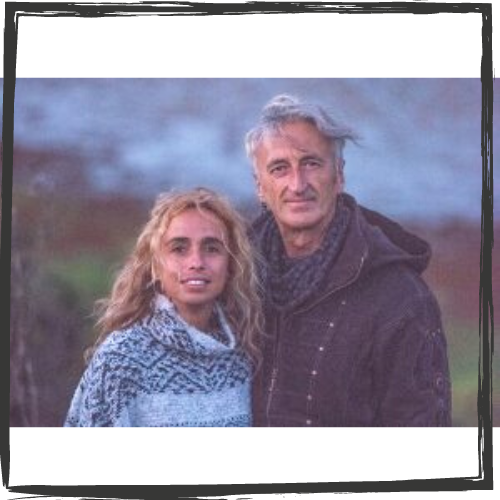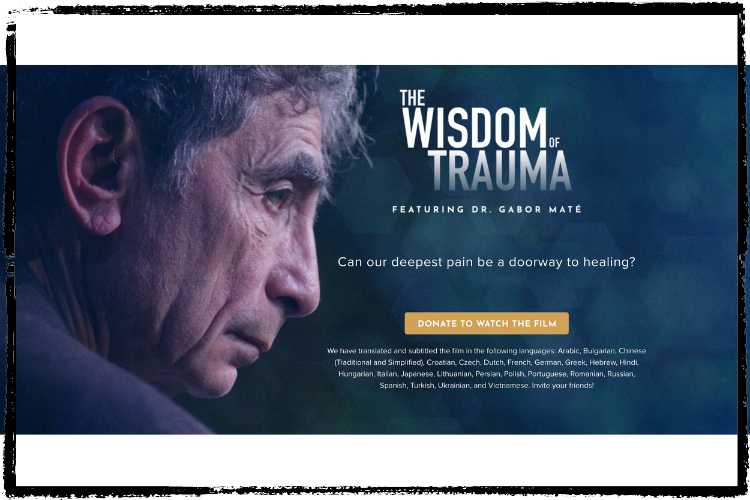By Travis Lupick, Yes! Magazine
“Our job, as human beings, is to learn from our suffering”
I've always been a rebel,” Gabor Maté says in The Wisdom of Trauma, a new documentary film about the acclaimed physician’s groundbreaking work in mental health. “In communist Hungary, in grade six, my teacher wrote in my report card that, ‘You should watch it, because he incites the other students.’”
Nearly 70 years later, although far from the playground, Maté is still doing exactly what his teacher warned. He is at the forefront of conversations about the long-term effects of childhood trauma, inspiring colleagues to transform the way Western society responds to depression, anxiety, addiction and other symptoms of deep-seated mental and emotional distress. His 2008 book, In the Realm of Hungry Ghosts: Close Encounters with Addiction, is a seminal work on the subject.
“Trauma is an overwhelming threat that you don’t know how to deal with,” he explains. “Our job, as human beings, is to learn from our suffering.”
It was also in Hungary that Maté had his own formative experience with trauma. When he was 2 months old, Nazi soldiers marched into Budapest. His Jewish grandparents were sent to Auschwitz and his father to a labor camp. His mother was left living in terror. Just before Maté turned 1, she handed him to relatives who took him into hiding. For six weeks, at this age crucial for development, Maté was separated from his mother—abandoned, in his infant mind—and surrounded by caregivers who had palpable fear for their lives.
It wasn’t until Maté was in his late 30s that he began to process this trauma. As a successful Canadian physician, he was a workaholic, addicted to his patients’ constant needs for attention. With his beeper going off at all hours of the day, he didn’t have to think about his own life, and he felt needed. Yet, the trauma remained, and, finally, Maté began to understand that keeping the trauma buried through constant work also kept his mind closed to much of his true self and the people who loved him.
For most of the past decade, I lived and worked as a journalist in Vancouver’s Downtown Eastside, the same neighborhood where Maté got his start working with drug users in the early 1990s. In The Wisdom of Trauma, he describes it as “North America’s most concentrated and most dramatic area of drug use, where there’s more people injecting and ingesting and inhaling more kinds of substances than anywhere else on the planet.”
It’s a dense population of poverty and mental illness where IV drug use is tolerated out in the open. There, I witnessed people go to dangerous lengths to hide from their pain. I saw women sell their bodies in dirty back alleys, young men rob and steal from one another and people shoot so much dope that they overdosed and nearly died. I also saw a community in the Downtown Eastside, as Maté did when he first arrived to work at a supportive-housing project there. “I felt totally at home, right away,” he says in the film.
Of his patients, Maté reports, “They all suffered tremendous torment as children, which also meant that their addictions were extreme. They were quite willing to sacrifice love, life, relationship, health, just for the next hit. They were that desperate to escape from reality because reality had been so cruel to them.”
Maté used his work as an escape. His patients escaped by using heroin and other drugs.
“Trauma fundamentally means a disconnection from self,” Maté says. “Why do we get disconnected? Because it’s too painful to be ourselves.”
In the Downtown Eastside, where so many people had gathered to hide from their pain, Maté helped them connect with the neighborhood’s community and reconnect with themselves.
The film, produced and directed by Zaya and Maurizio Benazzo of Science and Nonduality, includes many interactions between Maté and his patients. It is remarkable to watch how quickly Maté connects with people, understands where their trauma originates, and begins to help them work through it to find themselves.

In a therapy circle at Chrysalis House in Vancouver, a woman recounts being kidnapped by a taxi driver when she was 16 years old. She was held in a motel room for six months and repeatedly sold off and raped. Maté’s first question for her is about what steps her mother took to find her. “My mom just thought that I had run away from home,” she replies. “She didn’t look for me.”
He goes back further, and learns that, beginning when the woman was 5 years old, her father beaten her violently with a belt. Again, her mother was not there for her.
“Who did you talk to?” Maté asks.
“Nobody,” she replies.
“That’s the trauma,” Maté says. “By the time you were 5 years old, you were completely alone.”
Today, Maté sees dislocation from self in every direction he looks, as well as its symptoms, both mental and physical.
"We have a social structure that induces trauma in a lot of people. Therefore, it induces escapist, addictive behaviors.”
Think video games, social media, unrestrained consumerism, compulsive eating and the overdose crisis, which killed a record 93,000 people in 2020. People are hurting, he emphasizes. It’s a subject he discusses further in his newest book, The Myth of Normal: Trauma, Illness, and Healing in a Toxic Culture.
“Our schools are full of kids with learning difficulties and mental health issues that are trauma-based, but the average teacher never gets a single lecture on trauma,” he says. “The criminal justice system has no understanding or even acquaintance with the concept of trauma. In fact, they often create policies that further deepen people’s trauma.”
One of the more striking scenes in the film is a visit that Fritzi Horstman, founder of the Compassion Prison Project, makes to a maximum-security facility in California. She has dozens of inmates form a large circle and, standing in the center of it, asks the men, “If a parent or other adult in the household often pushed, grabbed, slapped, or threw something at you, step inside the circle.” Almost every one of them does. “If you often felt that no one in your family loved you, step inside the circle.” Again, almost everyone moves forward.
Roughly 64% of American prisoners have experienced six or more Adverse Childhood Experiences, or ACEs, which health professionals count on a 10-point scale that quantifies a person’s trauma and, with it, their likelihood of developing ailments ranging from cancer to an addiction to opioids.
"Trauma is not what happens to you. Trauma is what happens inside of you as a result of what happened to you."
Once Horstman’s circle of prisoners is much tighter than when the exercise began, it becomes apparent that these young men—muscle-bound, tattooed, and maintaining hard stares—are victims of childhood trauma. Instead of offering help, our system confined them to cages, severing their connections to friends, family and society.
The Wisdom of Trauma urges its audiences to ask why, collectively, we respond to trauma the way that we do in schools, hospitals and the criminal legal system.
“Childhood trauma is key,” an unnamed inmate says. “Because once you understand that, you know you were a child, and you didn’t have help. If it’s about love, then why are we locking you up?”
Read the original article here.
Travis Lupick is a journalist and the author of “Light Up the Night: America’s Overdose Crisis and the Drug Users Fighting for Survival.”
You can watch The Wisdom of Trauma documentary by contributing a small amount on the website.


